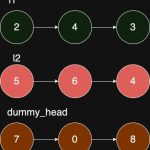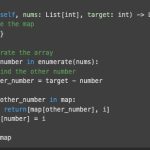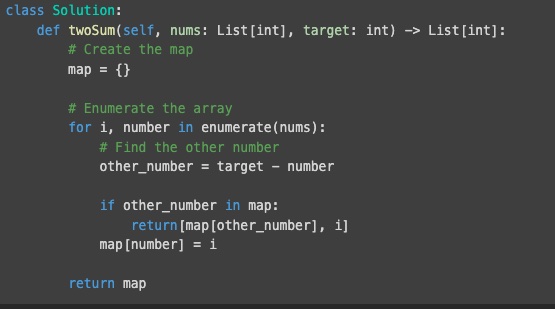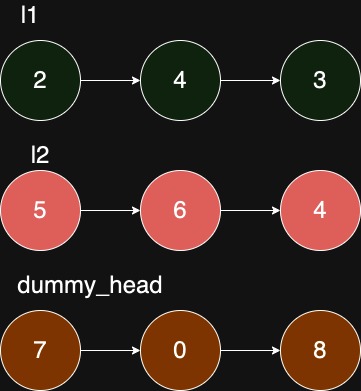Introduction
LeetCode Problem #1, commonly known as the “Two Sum” problem, is a fundamental coding challenge that tests a programmer’s ability to manipulate arrays and hash maps efficiently. It is one of the most frequently asked questions in coding interviews, making it essential for both novice and experienced developers to master. This article delves into the details of the Two Sum problem, providing insights, strategies, and solutions to help you ace this challenge.
Problem Statement
Given an array of integers nums and an integer target, return indices of the two numbers such that they add up to target.
You may assume that each input would have exactly one solution, and you may not use the same element twice.
You can return the answer in any order.
Example 1:
Input: nums = [2,7,11,15], target = 9 Output: [0,1] Explanation: Because nums[0] + nums[1] == 9, we return [0, 1].
Example 2:
Input: nums = [3,2,4], target = 6 Output: [1,2]
Example 3:
Input: nums = [3,3], target = 6 Output: [0,1]
Constraints:
2 <= nums.length <= 104-109 <= nums[i] <= 109-109 <= target <= 109- Only one valid answer exists.
Follow-up: Can you come up with an algorithm that is less than O(n2) time complexity?
Importance of Solving the Two Sum Problem
The Two Sum problem is not only a classic algorithmic challenge but also a stepping stone to understanding more complex problems. Solving this problem enhances your ability to think logically and implement efficient algorithms, which is crucial in technical interviews and real-world applications.
Approaches to Solve Two Sum
Brute Force Approach
The simplest way to solve the Two Sum problem is to check each pair of numbers to see if they add up to the target i.e. for each element we have to identify the find the other element by scanning through the remaining elements.
Complexity Analysis
- Time complexity: O(n).
This approach involves nested loops and has a time complexity of O(n^2).. - Space complexity: O(n).
In terms of space complexity, the size does not depend on the input array so it will be constant O(1).
Optimized Approach Using Hash Map
A more efficient approach is to use a hash map to store the difference between the target and each element. This method reduces the time complexity to O(n) by allowing constant-time lookups.
Detailed Steps for the Hash Map Approach
- Initialize an empty hash map.
- Iterate through the array, and for each element, do the following:
- Calculate the complement (target – current element).
- Check if the complement exists in the hash map.
- If it exists, return the indices of the current element and the complement.
- Otherwise, add the current element and its index to the hash map.
Code Implementation
Here’s a Python implementation of the hash map approach:
def two_sum(nums, target):
hash_map = {}
for i, num in enumerate(nums):
complement = target - num
if complement in hash_map:
return [hash_map[complement], i]
hash_map[num] = i
Complexity Analysis
- Time complexity: O(n).
This process scans any item only once in the list so the time complexity cost is O(n) as there are n items. - Space complexity: O(n).
The storage in the hash map is only once for each item so the space complexity cost is O(n) as there are n items.
Edge Cases and Considerations
When solving the Two Sum problem, it’s important to consider various edge cases such as:
- The array containing negative numbers.
- Multiple pairs summing to the target (though the problem guarantees one solution).
- Very large arrays and integer values.
Optimizing for Performance
To further optimize the Two Sum solution:
- Use efficient data structures like hash maps for O(1) average-time complexity operations.
- Avoid unnecessary computations by breaking the loop early when a solution is found.
FAQs
What if there are multiple pairs that sum up to the target?
The problem guarantees that there is exactly one solution, so multiple pairs are not considered.
Can the input array contain negative numbers?
Yes, the input array can contain negative numbers, and the solution should handle them correctly.
How does using a hash map improve performance?
A hash map allows for O(1) average-time complexity for lookups, significantly reducing the overall time complexity compared to the brute force approach.
Is it possible to solve the problem in a single pass?
Yes, the hash map approach solves the problem in a single pass through the array.
What are some variations of the Two Sum problem?
Variations include finding all pairs that sum to a target, handling duplicate elements, and solving the problem in a sorted array.
How can I practice more problems like Two Sum?
LeetCode and other coding platforms offer a wide range of similar problems to practice. Focus on problems that involve arrays, hash maps, and algorithmic thinking.
Conclusion
Mastering the Two Sum problem on LeetCode is a vital step in preparing for technical interviews and improving your problem-solving skills. By understanding the problem statement, exploring various approaches, and considering edge cases, you can develop efficient and optimized solutions. Keep practicing and exploring similar challenges to enhance your coding proficiency and confidence.








